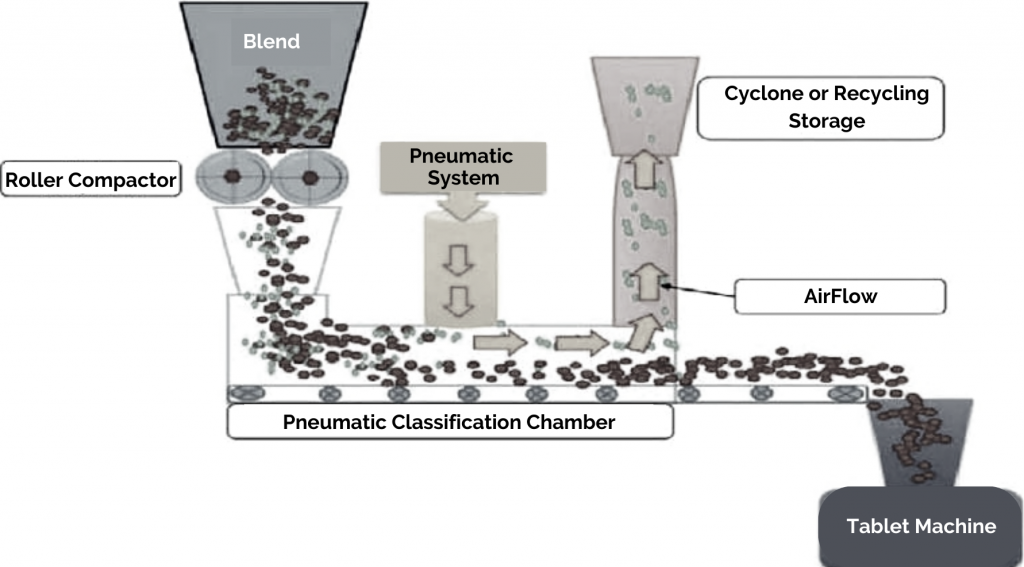Granulation is the process of turning fine powder particles into blends that are easily compressed into tablets or used for vial or capsule filling. These blends are free flowing, dust free, non-segregating, and have an ideal distribution of formulation ingredients.
Wet granulation and dry granulation are the two basic categories for granulation. These techniques are divided into groups based on the kind of binder used and the granulation procedure used.
This article will go in-depth on current developments in granulation technology.
Technological Advancements in Dry Granulation Technique:
Without the use of a binder solution or heat, tiny powder particles are aggregated during the dry granulation process. Roller compaction or slugging, commonly referred to as twofold compression, can be used to complete the process. Dry granulation technology has made few advances, with the exception of one important novel technique known as pneumatic dry-granulation.
- Pneumatic Dry Granulation (PDG) Technology
In order to create free-flowing granules with increased compressible properties, the PDG process combines roller compaction with a unique air classification technique. In this method, fine powder particles are first compressed with a little amount of force by a roller compactor, resulting in a mass that is composed of a mixture of fine powder particles and granules. The tiny granules and/or fine powder particles are then added to a newly developed fractionating apparatus, which separates the granules and recycles the rejected fraction.

Technological Advancements in Wet Granulation Technique:
There have been several scientific and technological advancements in wet granulation technology, including
- Steam Granulation Technology:
This is a different method of wet granulation. In essence, it entails the wet massing of tiny powder particles using steam rather than water as the granulation fluid. In this method, the bed of fluidized particles to be granulated is injected with a jet of steam to aid in the agglomeration of powder particles. After the steam condenses, a heated, thin film of water surrounds the powder particles, which requires a little amount of additional energy to remove.
- Moisture-Activated Dry Granulation (MADG) technology:
Moisture-activated dry granulation, also known as ‘Single-Pot’ or moist granulation, is a type of granulation in which agglomeration is aided by the addition of a tiny quantity of water, generally less than 5%, to the powder mix as it is constantly mixed in a high-shear mixer. After reaching the granulation endpoint, moisture absorbents such as microcrystalline cellulose (MCC), silicon dioxide, potato starch, and others are added to aid in the absorption of surplus moisture in the granules.
- Thermal Adhesion Granulation (TAG):
The technique includes submitting formulation components including a very tiny amount of water/solvent to a temperature range of 30°C to around 130°C in a closed system under tumble rotation to encourage agglomeration of the fine powder particles. This method is similar to wet granulation in that it uses a tiny amount of granulating fluid and heat to agglomerate. Unlike MADG, which solely employs water as a granulation fluid, TAG technology uses both water and solvent.
- Melt Granulation Technology:
Melt granulation, also known as thermoplastic granulation, works on the same principles as wet granulation. The standard wet granulation binder solution is replaced with a meltable binder such as wax or polyethylene glycol (PEG), which is either added in solid form and melted during the process by adding the necessary energy or in the form of molten liquid, optionally containing the dispersed drug, in this technique.
The granules are cooled to room temperature after particle agglomeration and consolidation, and the solidified binder creates bridges between individual powder particles to give a solid final product with a granular structure.
- Freeze Granulation Technology:
This method involves spraying droplets of liquid slurry or powder suspension into liquid nitrogen, where the drops instantly freeze to create granules. The frozen droplets are then freeze-dried to produce free flowing dry granules with excellent uniformity.
- Foam Granulation or Foamed Binder Granulation (FBG):
Instead of spraying or pouring liquid onto the powder particles, the approach includes continuously adding liquid/aqueous binder (e.g., hydroxypropylcellulose or hypromellose) as foam with the viscosity of shaving cream. After reaching the granulation end-point, the wet granules are dried in a fluidized bed processor to the required moisture content.
- Reverse-Phase Wet Granulation/ Reverse Wet Granulation:
Reverse wet granulation is a revolutionary granulation process that includes immersing a dry powder mix in a binder solution and then controlled breaking to generate free flowing granules with uniform particle size. The process moves toward less liquid saturation, lowering the likelihood of uncontrolled growth and batch losses.
Summing up:
In today’s competitive world, every medication manufacturing business strives to have the most efficient and hence cost-effective product research and manufacturing operation possible. Because granulation technology can result in expensive batch rejections if unsuitable procedures are applied, it is critical to properly evaluate the impact of granulation technology on the stability of each formulation ingredient.






